The firemouth cichlid is a popular freshwater fish in the cichlid family, native to Central America, particularly Mexico, Belize, and Guatemala. This species is well-known for the striking bright red coloration on its throat and lower jaw, a feature that is prominently displayed during courtship and territorial behavior.
Hobbyists are drawn to firemouth cichlids not only for their vibrant appearance but also for their engaging behaviors and relatively straightforward care requirements. They thrive in well-planted aquariums with plenty of hiding spots, making them suitable for both beginner and experienced aquarists. Their territorial nature adds an interesting dynamic to community tanks, especially when paired with compatible species.
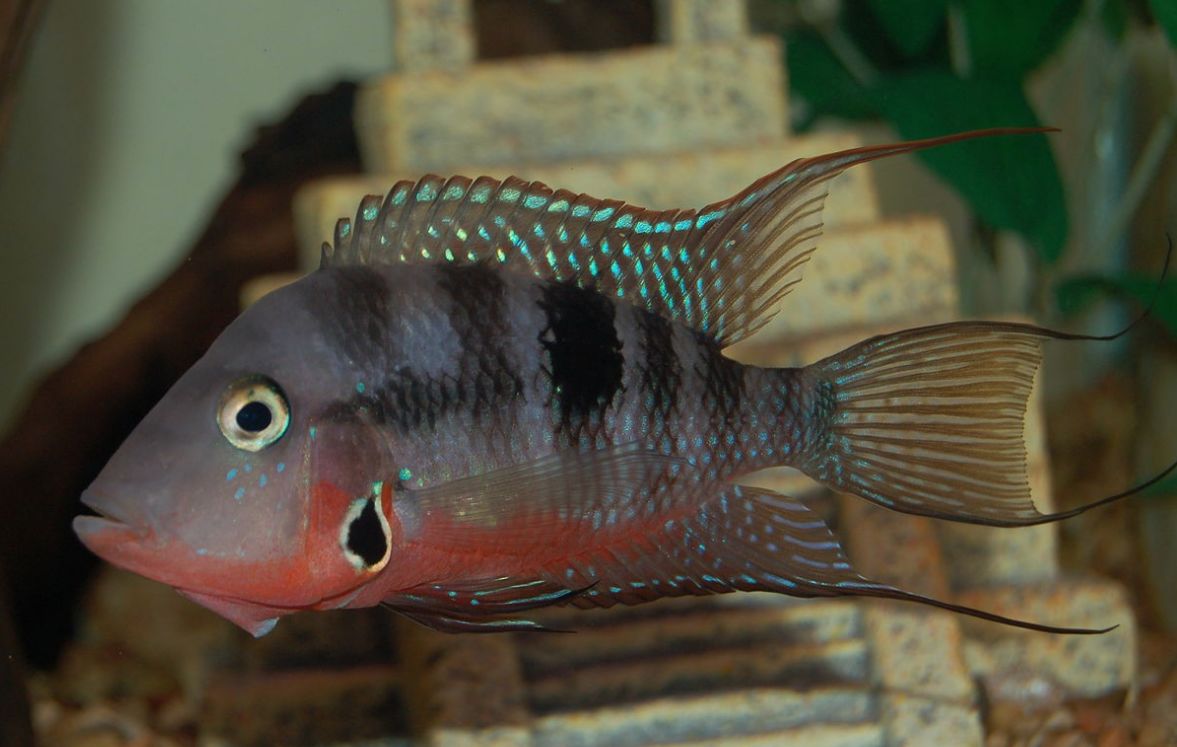
Contents
Inhabitance in the wild
The firemouth cichlid, a member of the diverse cichlid family, is a popular choice among aquarium enthusiasts. Known for their vibrant colors and engaging behaviors, cichlids are widely distributed across regions like Africa, Central and South America, and parts of Asia.
Specifically, the firemouth cichlid belongs to the subfamily Cichlasomatinae, which includes various cichlid species primarily found in Central America. Other notable species in this subfamily include the convict cichlid, Jack Dempsey, and Green Terror. These cichlids share behaviors such as parental care and territoriality, along with distinctive color patterns.
Named after American ichthyologist Seth Eugene Meek, the firemouth cichlid was first described in 1918 by Walter Brind. This species inhabits several Central American countries, including Mexico, Guatemala, El Salvador, Honduras, Nicaragua, Costa Rica, and Panama.
In their natural habitat, firemouth cichlids prefer the bottom and middle layers of slow-moving waters, ponds, and areas with sandy or muddy substrates. They often seek shelter in densely planted regions where they feed on both plant and animal matter. These fish thrive in environments with dense vegetation, rocky structures, and submerged roots or branches.
Typically found near shorelines, firemouth cichlids establish and defend territories, particularly in areas with ample vegetation cover. They adapt well to varying water conditions, but generally, they inhabit waters with temperatures ranging from 75 to 82°F (24 to 28°C) and a pH level that is slightly acidic to neutral, typically between 6.5 and 7.5.
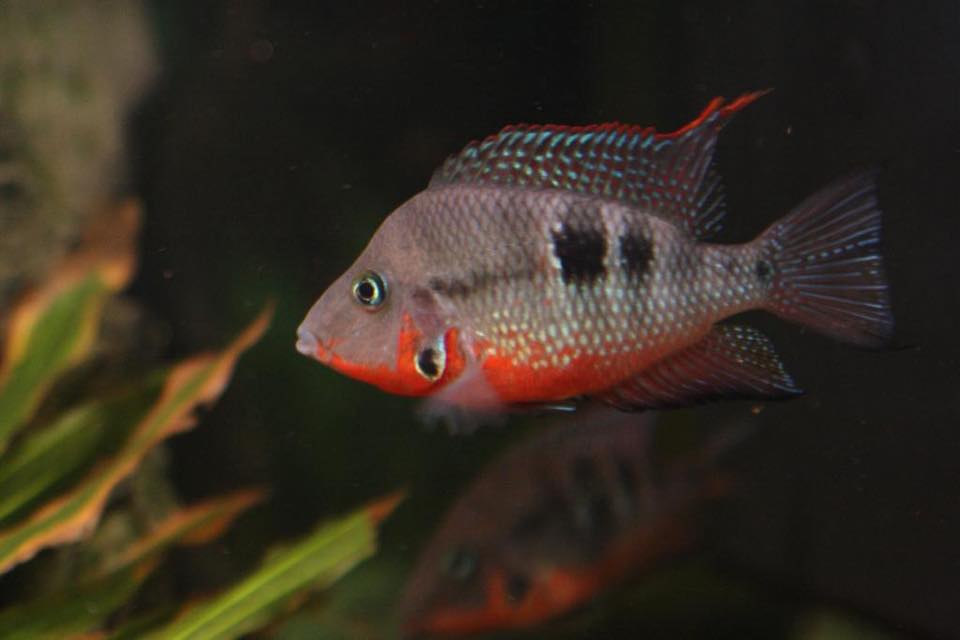
Description
Firemouth cichlids have an elongated body that is slightly laterally compressed, featuring the characteristic rounded head and single dorsal fin typical of cichlid species. Their large eyes enhance their facial appearance, contributing to their striking look.
The primary body color of firemouth cichlids ranges from light gray or olive gray with a bluish tint, maturing to a vibrant violet in adults. Depending on their state and environmental conditions, they may display wide dark transverse stripes, a lateral stripe, and a prominent black spot in the middle of their body. The most distinctive feature, however, is the bright red or orange coloration on the underside of their throat and lower jaw, which gives them their name. The abdomen, neck, and opercles also exhibit red or orange-red hues, with males showcasing more intense coloring. Their opercles feature a black spot, and the iris is bluish, while the unpaired fins are pinkish with blue sparkles.
The dorsal fin’s upper edge is red, and both the dorsal and anal fins are pointed. Notably, the cichlid’s colors become more vibrant when the fish is excited or during spawning.
Size: In captivity, firemouth cichlids typically reach a maximum size of about 5 to 6 inches (12 to 15 cm), while those in the wild tend to be slightly smaller. Individual sizes can vary, with some fish growing larger or smaller than average. Males usually outgrow females.
Growth Rate: The growth rate of firemouth cichlids can vary based on factors like genetics, diet, water conditions, and overall care. Generally, they exhibit a moderate growth rate compared to other cichlid species. On average, they reach about 1 to 2 inches (2.5 to 5 cm) within their first few months. By the end of their first year, they can grow to approximately 3 to 4 inches (7.5 to 10 cm). After this initial growth phase, their rate may slow, taking a couple of years to reach their adult size of 5 to 6 inches (12 to 15 cm).
Lifespan: Firemouth cichlids have an average lifespan of around 8 to 10 years in captivity, though with proper care, some individuals can live even longer, potentially reaching up to 12 years or more.
| Characteristic | Description |
|---|---|
| Scientific Name | Thorichthys meeki |
| Common Name | Firemouth Cichlid, firemouth fish, red belly cichlid |
| Family | Cichlidae |
| Origin | Central America (Mexico, Belize, Guatemala) |
| Size | Up to 5-6 inches (12-15 cm) in captivity |
| Lifespan | 8-10 years (can vary with proper care) |
| Body Shape | Elongated body with a rounded head |
| Coloration | Beige or light gray with dark vertical bands |
| Unique Feature | Bright red or orange coloration on throat and lower jaw |
| Temperament | Can be somewhat aggressive, especially during breeding |
| Tank Size | Minimum of 30 gallons (113 liters) |
| Water Temperature | 75-82°F (24-28°C) |
| pH Level | 6.5-7.5 |
| Diet | Omnivorous, eats flakes or pellets with occasional live/frozen foods |
| Breeding | Monogamous, pair-bonding, parental care |
| Compatible Tank Mates | Other robust Central American cichlids (e.g., Convict Cichlids, Severum Cichlids) |
| Preferred Habitat | Slow-moving or still waters with vegetation and rocky areas |
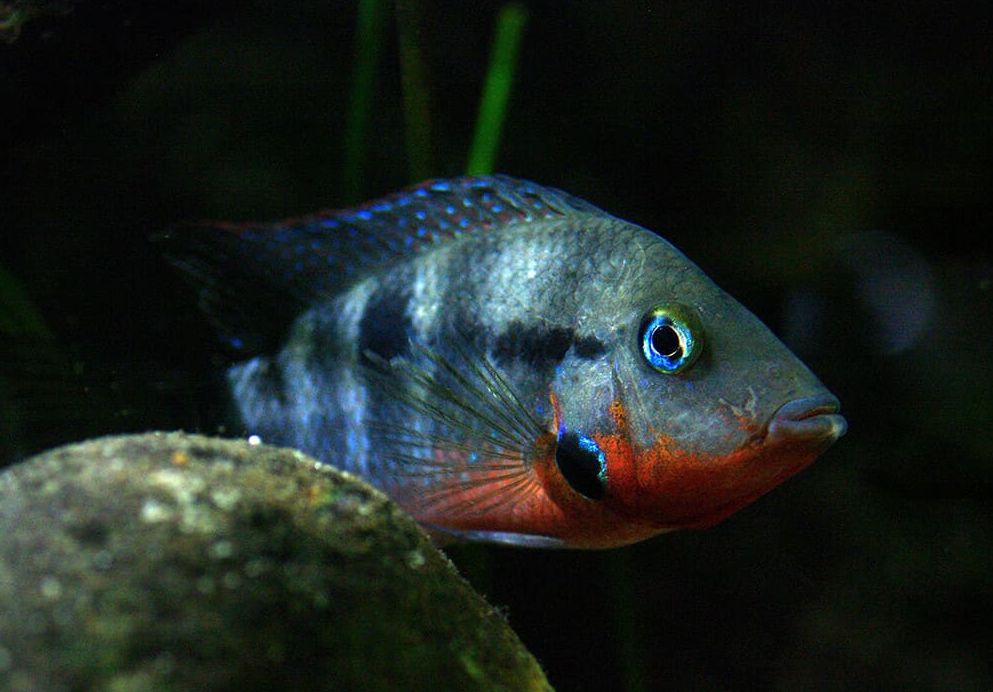
Care and keeping in a tank
Tank size
The firemouth cichlid is often regarded as one of the more peaceful cichlid species, making it an excellent choice for community aquariums. A single pair can comfortably thrive in a 30-gallon (113-liter) tank, where they will establish their territory and potentially breed. It’s essential to include plenty of hiding spots and visual barriers, like plants or rocks, to help create distinct territories, especially if you plan to keep multiple pairs.
For larger tanks, such as a 55-gallon (208-liter) or 75-gallon (283-liter) setup, you can consider housing several pairs or a small group of firemouth cichlids. However, it’s crucial to monitor their behavior closely. Ensure there are enough hiding spots to reduce aggression and minimize potential conflicts, as even generally peaceful species can display territorial behavior when they feel crowded.
Water parameters
Firemouth cichlids are not particularly demanding regarding water chemistry; however, many experienced aquarists have observed issues with early mortality, especially when imported fish are not properly quarantined. To promote the health and longevity of these fish, it’s essential to maintain optimal water parameters.
Temperature: Firemouth cichlids thrive in water temperatures between 75-82°F (24-28°C). Keeping the temperature stable within this range is crucial for their comfort and overall health.
pH Level: These fish prefer slightly acidic to neutral water, with a recommended pH range of 6.5 to 7.5. Maintaining a stable pH within this range supports their well-being.
Hardness: Firemouth cichlids can tolerate moderate water hardness. Aim for a general hardness (GH) level between 8 and 12 dGH (143 to 214 ppm) and a carbonate hardness (KH) level between 6 and 12 dKH (107 to 214 ppm).
Ammonia, Nitrite, and Nitrate: It’s vital to keep ammonia and nitrite levels at zero or as close to zero as possible, as these compounds are toxic to fish. Regular water testing and proper filtration are essential for maintaining a healthy nitrogen cycle. Nitrate levels should be kept below 40 ppm, ideally below 20 ppm, through routine water changes.
Filtration and Water Changes: A good filtration system that provides mechanical, biological, and chemical filtration is beneficial for firemouth cichlids. This ensures water quality and clarity. Regular water changes of about 20-30% every 1-2 weeks help remove accumulated pollutants and maintain optimal conditions in the aquarium.
Tank decor
When decorating an aquarium for firemouth cichlids, it’s essential to create an environment that closely resembles their natural habitat while providing suitable hiding spots and territorial boundaries.
Firemouth cichlids thrive in environments with rocks and caves. Use stacked rocks to create stable caves and crevices where the fish can establish their territories and find shelter. Ensure that the rocks are securely positioned to prevent any accidents.
Incorporating driftwood or root structures can further enhance the habitat, providing additional hiding places and fostering a natural setting. Cichlids may also graze on the biofilm that develops on the surface of the wood, which can serve as a supplementary food source.
Utilizing decorations to create visual barriers can help define separate territories within the tank. Arrange rocks, driftwood, or tall plants strategically to break lines of sight and establish distinct areas for each pair or group of cichlids. This setup promotes a more harmonious environment, reducing stress and potential aggression.
Substrate
Contrary to what some reference books may suggest, firemouth cichlids are not heavy diggers. Their digging behavior is generally moderate, especially when provided with large clay pots or other shelters for spawning. Overall, their behavior can vary significantly based on environmental conditions and individual preferences. Some aquarists find firemouth cichlids to be active diurnal fish, while others note that theirs often spend most of their time in hiding.
When choosing a substrate for your aquarium, consider the following popular options:
Fine Sand: Firemouth cichlids naturally inhabit sandy areas in their native habitats. Using fine sand in your aquarium can help replicate this environment, allowing the fish to sift through and dig as they would in the wild. Ensure that the sand is aquarium-safe, with no sharp or abrasive particles that could harm the fish.
Smooth Gravel: Another viable option is smooth gravel. Choose gravel with rounded edges to prevent any potential injuries. The gravel should be small enough to allow the cichlids to sift through it comfortably. A layer of gravel can also enhance biological filtration by providing a surface for beneficial bacteria to colonize, contributing to a healthier aquarium environment.
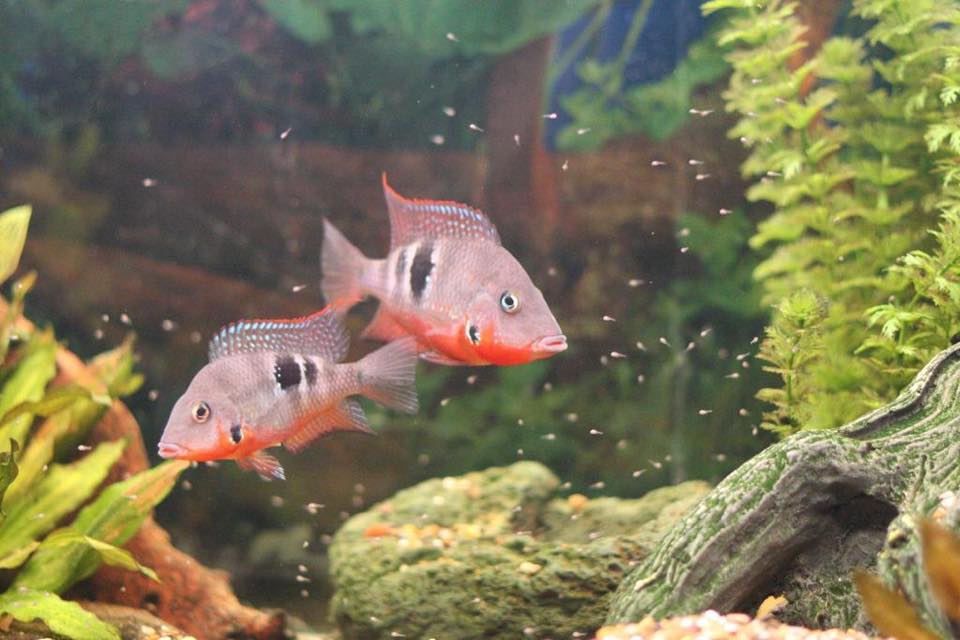
Tank mates
An important aspect often overlooked is that firemouth cichlids have a relatively low ability to handle stress. When surrounded by larger, more aggressive species, they may not feel safe or confident, which can lead to stress-related health issues. In fact, a firemouth cichlid can succumb to a harmless disease simply due to stress.
Males are particularly vulnerable to harassment from larger tank mates, while females exhibit an interesting behavior by seeking protectors among other fish species in the tank. Given this context, firemouth cichlids may not be well-suited for tanks with other cichlid species.
To create a more harmonious community, consider adding some active schooling fish. Larger tetra species, such as serpae tetra, glowlight tetra, and rummy nose tetra, can be compatible companions for firemouth cichlids. Pictus catfish can also make good tank mates. It’s advisable to avoid slow-moving and especially long-finned fish, as they may become targets for aggression.
How many firemouth cichlid should be kept together?
When keeping firemouth cichlids together, it is generally best to maintain them in pairs or small groups. This arrangement mimics their natural social behavior and can help reduce aggression and territorial disputes.
While firemouth cichlids are not traditional schooling fish, adult males in the wild typically establish their own territories, fiercely defending them by flaring their gills to scare off rivals. They attract females during spawning by swimming attractively. In contrast, females and juveniles often stick together.
Firemouth cichlids spend most of their time in still waters near the shore, under cover from plants and snags. They form pairs primarily during spawning and for caring for their young. In a tank setting, it’s important to consider the tank size; larger tanks can accommodate 2-3 pairs along with other species.
It’s fascinating to observe how two spawning pairs can gather and share the care of their juveniles without concern for ownership. Unlike species such as discus or uaru, there is no clear hierarchy in such groups. A mix of fish of different ages can help reduce rivalry and avoid inbreeding.
In medium-sized tanks, space typically allows for only one male. If another male is present, conflicts are likely, which can even lead to one fish being killed. However, 2 or 3 females can coexist successfully, with the male spawning with each in turn.
It’s worth noting that this is not a classic harem setup, like those seen with some dwarf cichlids. In smaller tanks, it’s advisable to keep only one cichlid or a single pair. Larger tanks provide a more stable biological environment, making the fish feel safer and more comfortable, which is crucial since firemouth cichlids have specific needs for both stability and space.
Can firemouth cichlids live with african cichlids?
It is generally not recommended to keep firemouth cichlids with African cichlids for several key reasons:
Different Water Requirements: African cichlids, particularly those from Lake Malawi, Lake Tanganyika, and Lake Victoria, have specific water parameter needs, including higher pH and hardness levels than firemouth cichlids. Mixing these different requirements can lead to stress and health issues for both species.
Aggression and Territoriality: Many African cichlids are known for their aggressive and territorial behavior. When combined with firemouth cichlids, which can also exhibit territorial tendencies, this can result in heightened aggression and territorial disputes, leading to fin nipping, stress, and potential harm.
Diet Differences: Firemouth cichlids have a more omnivorous diet, while many African cichlids have specific dietary needs or specialized feeding behaviors. Providing a suitable diet that meets the requirements of both species can be challenging.
If you do decide to mix these species despite the risks, careful monitoring and consideration of their specific needs will be essential to ensure a harmonious aquarium environment.
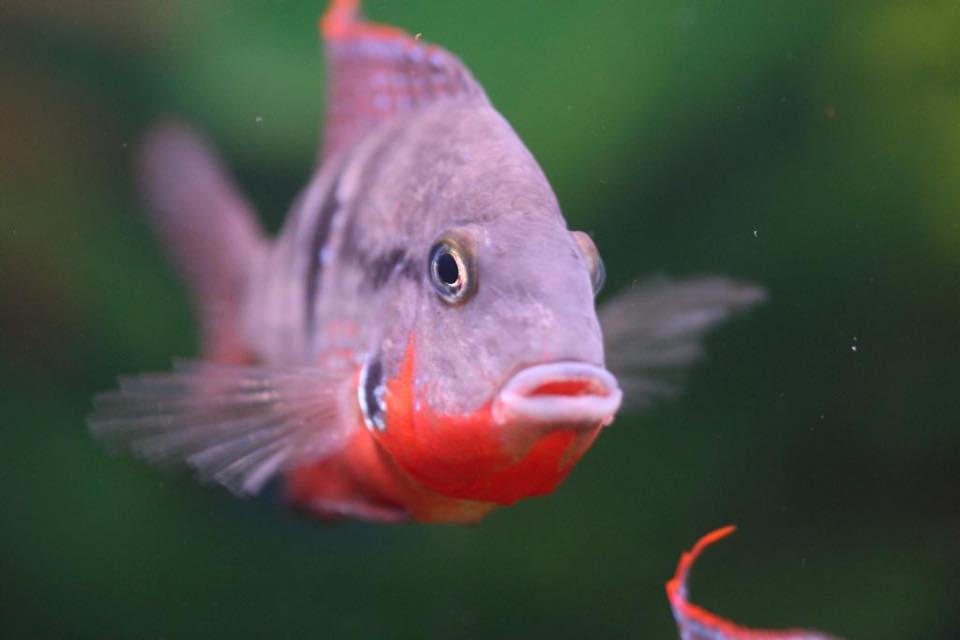
Diet
Firemouth cichlids are omnivorous and thrive on a varied diet in the wild. To promote their optimal health in captivity, it’s essential to provide a balanced diet.
In an aquarium, they eagerly consume live foods such as bloodworms, tubifex, white worms, and brine shrimp. You can offer occasional treats like daphnia or mosquito larvae, along with small live or frozen insects, such as blackworms or small crickets. Frozen foods, including brine shrimp and cyclops, are also beneficial.
A staple diet should include high-quality commercial pellets or flakes specifically formulated for cichlids, ensuring they contain a good balance of proteins, vitamins, and minerals.
Gender differences: male vs female
There are several physical and behavioral differences that can help identify the sexes:
Size: Males are generally larger than females. Adult males can reach lengths of 5-6 inches (12-15 cm), while females typically grow to about 4-5 inches (10-12 cm). This size difference becomes more noticeable as they mature.
Body Shape: Males tend to have a more elongated and streamlined body shape, particularly during breeding periods. In contrast, females often exhibit a slightly rounder and bulkier body.
Coloration: One of the most striking differences is in coloration. Males develop vibrant colors, especially during breeding or display, showcasing bright red or orange hues on their throat and lower jaw. This coloration intensifies during courtship or when defending their territory. Females usually have a more subdued appearance with less intense colors.
Fin Shape and Extension: Males typically have longer, more pointed dorsal and anal fins compared to females. During breeding, these fins may feature extensions or filaments that are absent in females.
Behavioral Differences: Males are generally more territorial and aggressive, particularly when establishing their territories or defending their mates and eggs. While females are less aggressive, they can still display protective behavior when guarding their eggs or fry.
Breeding
Firemouth cichlids reach maturity at approximately 8-12 months of age. When kept in groups, they typically form pairs that will separate from the group. In an aquarium setting, these cichlids often exhibit more loyalty and affection towards each other than their wild counterparts, who come together primarily for spawning.
While a single male may spawn with multiple females in captivity, forced pairings often lead to stress and aggression, resulting in the couple eating their eggs. In the wild, firemouth cichlids spawn on open substrates, but in an aquarium, they prefer to lay eggs in sheltered areas. Interestingly, some females may choose hidden spots where the larger male cannot access them for fertilization, a consideration to keep in mind for successful spawning.
Both parents guard the clutch, which typically contains 100-400 eggs. The incubation period lasts about 3-6 days, and within 4-5 days, the juveniles begin to swim. If spawning occurs in a community tank, it’s advisable to move the clutch to a separate container or use a hose to transfer the juveniles once they start swimming. Parents may struggle to protect their young from other tank inhabitants in a mixed environment.
However, breeding in a separate tank can be challenging. In my experience, relocating a breeding pair to a new environment often leads to stress, causing them to stop eating. The male may adapt more quickly and attempt to force the female to lay eggs, resulting in injuries that may require treatment.
Firemouth cichlid juveniles are quite small—smaller than those of convict cichlids—and should initially be fed brine shrimp nauplii, cyclops, or specially formulated powders and suspensions. Some aquarists have faced high mortality rates when attempting to feed juveniles powdered flakes, highlighting the importance of feed quality and stable water conditions.
With adequate care and attention, breeding firemouth cichlids in an aquarium is not overly complicated, making them a popular choice among cichlid enthusiasts.